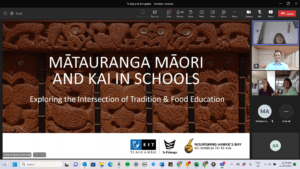
Two senior researchers at EIT | Te Pūkenga presented at the latest Te Kai a te Rangatira Lunchtime Research Presentation.
The presenters were Rachael Glassey on Exploring mātauranga Māori as a pathway to food security for rangatahi and Noor Alani on Empowering computer vision applications using agile methodologies.
For the first time, the presentation, held on October 25, was open to all researchers from Wintec, Toi Ohomai and Whitireia and Weltec. Over time, it is expected some researchers from those business divisions of Te Pūkenga will be included as presenters.
Rachael, a Postdoctoral Research Fellow of Te Kura i Awarua (Rangahau Māori Centre) and part of the Nourishing Hawke’s Bay (NHB) – He wairua tō te kai research group, said the aim of her project was to look at the connection between mātauranga Māori and kai in Hawke’s Bay primary schools.
“To our knowledge this is the first study exploring the pairing of mātauranga Māori and kai in schools. These findings support both international and NZ literature that Indigenous knowledge can and is being used to support kai initiatives, but further shows support that this can also occur in a school environment”.
Semi-structured interviews were undertaken with five primary school principals, part of the government’s free, healthy school lunch programme, Ka Ora, Ka Ako.
“We identified three themes, and they were: teaching and learning around mātauranga Māori and kai; environmental sustainability and the sustainability of kai initiatives; and school values.”
Rachael says a strong emphasis was placed on the learning of traditional Māori values around kai and the whenua (land) and the sustainability of teaching programmes.
“School values were invariably bound with Te Ao Māori (a Māori worldview) however, schools felt there were few learning opportunities for their students within the bounds of that programme and this was mainly related to the strict nutritional guidelines that the programme has which have actually been revised since I did this work last year.
“Schools remain an ideal environment for the incorporation of mātauranga Māori to support food security and food education, and future work should explore a demonstration project that incorporates the knowledge gained in this study and ways to integrate mātauranga Māori into Ka Ora, Ka Ako.”

Noor, a Senior Academic Staff Member at the School of Computing, spoke on a research topic he first started during his PhD about eight years ago.
“Understanding the Scrum methodology’s role in developing Computer Vision Applications has been increasingly imperative in industry-based learning. CVA are an emerging category of AI applications that use software technologies to monitor and control the environment using sensors (e.g. cameras).”
CVA is used in various fields, such as traffic safety, agriculture, healthcare, work productivity, retail, and more, to improve people’s lifestyles.
After analysing many research articles on road detection (one of the computer vision applications), Noor says only a few have considered the importance of such a domain.
“This study reviews the existing methodologies for developing computer vision based on agile, modelling, and service-oriented approaches. This also includes automated frameworks, platforms, and tools used to improve the development of computer vision applications and the design of their underlying architectures.”
Noor says there are enormous opportunities for Agile development to be represented in CVA that include but are not limited to traffic safety, better environment and better urban planning.”
“One of the biggest challenges is how to incorporate different sensor data using a popular Agile framework such as Scrum.
“There are different directions to this research to include more fields that are relevant to data analytics, computer vision or IoT.”
